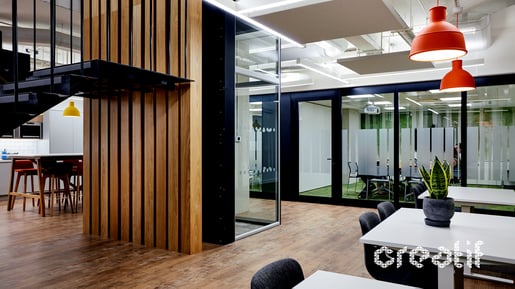|
In the fourth part in a series of posts about the ABC of Acoustic Design, we take a look at the principle of blocking sound in the workplace and the different ways that can be achieved through fixed and flexible partitions. Noise effects how we all work. Be it from the traffic rumbling outside, the music playing throughout the office or your colleague sat opposite, it all plays a part and can make or break how we perform. One of the most common ways to stop noise from impacting us in our everyday lives is to simply build walls. The external walls of our homes help keep sound in – and out – and it’s the same thing in commercial buildings too. Internally, one easy way to stop sound from transferring from one space to another is to section it off. This principle is about as old as time itself and is prevalent in office design throughout the ages. The concept arguably peaked during the cubicle farm days of the of the late-1970s and 1980s when dividers of all sizes separate on desk from the other, attempting to stop and block conversations from circulating around the workspace. And while office designs have shifted over the years, there’s still a lot to be said for erecting walls and other dividers to block sound at source. In fact, it’s one of the most effective ways of dealing with acoustic issues. Whenever we are presented with a brand-new scheme, we evaluate the floorplan and determine potential acoustic problems. We then identify areas where stopping sound may well be beneficial through the introduction of partitions, be they fixed or flexible. The good thing with blocking sound is that they are a myriad of ways to do it and unlike the cubicle farms of days gone by, the solutions in 2019 are every bit as aesthetic as they are functional. When it comes to the use of fixed partitions, it is important to use an acoustic-rated wall wherever possible.
Speaking from experience, there’s nothing worse than having a rather porous wall separating yourself from your next-door neighbours and it’s the same principle back in the office. You wouldn’t want the finer points of a HR meeting leaking out due to the poor acoustic performance of a dividing wall, so it’s important to consider acoustics, even when considering fixed partitions. Depending on the system and the surroundings, it’s possible to achieve an acoustic rating of 57dB from our Solo 125, which is the most obtainable on-site rating around. This is achieved through the composition of the wall itself where specialist inner panels, acoustic inserts and operable seals all work in unison to block and absorb soundwaves from penetrating through the panels. But as with all designs, different spaces will require different things. That’s why there’s a multitude of walls on offer. For example, you could look at incorporating a double-glazed glass wall if there was a need to maximise natural light.
Whatever you need from your moving wall, there’ll be an effective option that helps protect sound privacy. However, it’s important to note that a fixed wall will not be the solution for everyone. |
In recent years, there has been exponential growth in the use of open plan offices. And that raises a pertinent question: How do you block sound in an environment devoid of fixed partitions? Thankfully, the answer is a simple one: Through the use of lightweight and flexible partitions, such as screens and modular space dividers fitted with acoustic inserts.
These solutions offer workspace designers much more than their noise-blocking benefits. They can give designers the scope to create unique centrepieces that provide a dual function; stopping sound and separating space. Workplaces that are mostly open still need to provide users with ample private spaces and that’s where the use of these partitions come to the fore. Depending on the configuration and layout, these lightweight items can help workspace users create zones according to their needs and thanks to their acoustic properties, they will help block sound from escaping the space in question. Take our Whisper screens, for example. These can either be installed onto an overhead track to allow users to create mobile zones quickly and easily, or they can be used in a more traditional, static manner. Thanks to the unique composition of Whisper, it is effectively a design medium in itself and gives people the chance to fashion something truly unique that reflects the workplace in question. Recently, we produced a series of these screens for a global banking giant that matched the zones they’d be creating.
Similarly, the use of a modular space divider gives designers – and workspace users themselves – the ability to fashion zones and block sound from spreading. By following the principles outlined in this piece by using partitions – either fixed or flexible - to block sound, you can make a massive difference to the acoustics of a space. It couldn’t be easier! Our next piece will look at covering sound and the dark arts of using sound to stop sound. |



